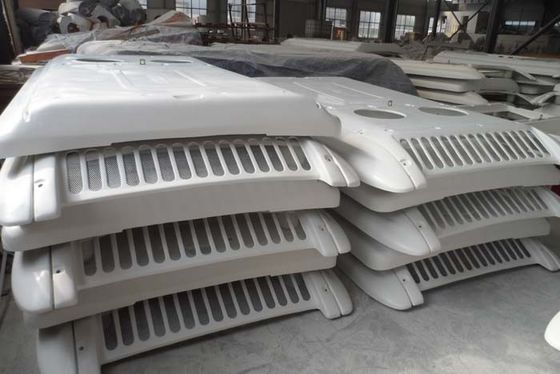Fiberglass bus parts/Customized Fiberglass spare parts/Fiberglass auto dashboard
Description:
Place of Origin:Qingdao Shandong, China (Mainland)
Brand Name: Lanmon
Model Number:Customized
Application:Various Fields
Surface Treatment: Gel coat Or Paint
Technique:Hand Lay-up RTM SMC
Material:Fibreglass Reinforced Plastic
Certificate:ISO9001
Process: Hand-lay up
In the hand lay-up process, the laminate structure, commonly a single continuous strand glass mat, a woven glass mat or an advanced composite mat is manually “hand-laid” in the mold. The catalyzed thermoset resin is introduced, and the materials are formed to fit the mold surface using a “roll-out” process, as well as a number of specialized laminating tools. Additional layers of reinforced mat can be added to key structural points to enhance rigidity and performance. The Hand lay-up process is most effective when molding complex surfaces, and is commonly used in the transportation, recreation, medical, and agricultural markets.
Process: RTM
Light RTM, a closed mold process, utilizes coordinating molds comprised of a rigid “A-side” mold, the base, and a lightweight rigid “B-side” mold that fits inside or on top of the A-side mold. Prior to affixing the two molds together, a pre-sized, cut and formed continuous strand glass mat, woven glass mat or Carbon fiber reinforcement is dry-loaded into the base mold. Rather than use pressure, RTM Light uses a vacuum, which pulls the catalyzed resin through the mold cavity, saturating the fiberglass reinforcement to create a part with consistent thickness, a smooth B-side surface, and controlled fiber/resin ratios. Relative to other Closed Mold Processes, Light RTM offers lower tooling costs.
Process: SMC
The SMC / BMC molding process is a method of putting a certain amount of SMC / BMC molding material into a metal counter-die and molding the product at a certain temperature and pressure. The SMC is widely used in transportation filed like interior parts of high speed rail, auto spare parts and construction fild. The SMC / BMC molding process has the following characteristics:
1 Short molding cycle, high production efficiency, suitable for mass production of products;
2 Molded products are cheap;
3 High degree of automation and mechanization can greatly reduce labor intensity;
4 The size of the molded product is accurate, the surface is smooth, the quality is stable, and the replaceability is good;
5 Most products can be formed at one time without post-processing.

Production Process:
1st:Mould treatment:
Polish: Mould must be polished before production which will guarantee the good and solidified surface
Clean: Special detergent are used to get the dust away from the mould which will make no dark markings in the
gel coat surface.
Release agent: This will be brushed on the mould to make ejection easily.
2nd Fiberglass and resin:
Gel coat: The color of products is decided by the gel coat,with thickness of about 0.3-0.5mm. UV resistant can
be added.
Surface mat: This is to avoid the air bubble on the surface, and also make fiberglass mat invisible from the finished
surface.
Fiberglass mat: Normally we use 300g/m2 (0.6mm thickness) and 450g/m2 (0.9mm thickness). According to your
requests on the thickness and strength, we will calculate how many layers of fiberglass mat should be used.
3rdSolidify: The time required for solidifying depends on thickness and weather condition.Normally 24 hours for one
piece to solidify to avoid any deformation after demoulding.
Demould: After solidified, the product will be demoulded
Cut and trim: We will mark the trim line and hole positions on the mould,then trim according to the marks to
gaurantee the mounting dimensions
4th Adhesion: Professional mould and Temperature and worker
5th Surface treatment :
6th Painting
7th Package Solution:
Our principle: Safe and economical
We choose economical packaging on condition that there will be no damage during transportation.Shipping: We are very glad to get the freight cost information for you
as we have long term cooperated forwarder company.
Value Added Services
• Materials formulated for UV-stability, stain-resistance
• Engineering and design support
• Secondary component installation
• Bonding services
• Thermal and acoustical insulation
• with your different requirement
Quality and Other Certifications
• ISO-9001
• UL-certifiable
• Flame retardant
• ROHS and EU REACH approved materials
Electrical Distribution Enclosures
• Transformer Housings
• Transformer Pads
Utility Cross-arms and Components
Benefits of Composites(frp)
• Strong, durable – long life under even extreme weather exposure
• Lightweight – easy to transport and install
• Reinforcement offer superior sidewall strength
• UV protection
• Fire retardant
• Fast turn-up on production
Tag Words:
The FRP products have the following advantages:
Corrosion resistance, good impact toughness, high strength, low mold cost, easy operation, short development cycle, etc. At the same time, it can achieve any complex form of high quality surface, which is very suitable for the manufacture of bus body and interior. Including new product development.
FRP is widely used in large internal and external coverings, such as: canopy, front and rear, luggage compartment door, bumper, instrument panel, air duct, interior trim and so on. The adoption of FRP increases the corrosion resistance, sound insulation and heat insulation of the vehicle body, and enables the passenger car to be lighter in weight, which can save a lot of energy.


 Your message must be between 20-3,000 characters!
Your message must be between 20-3,000 characters! Please check your E-mail!
Please check your E-mail!  Your message must be between 20-3,000 characters!
Your message must be between 20-3,000 characters! Please check your E-mail!
Please check your E-mail! 







